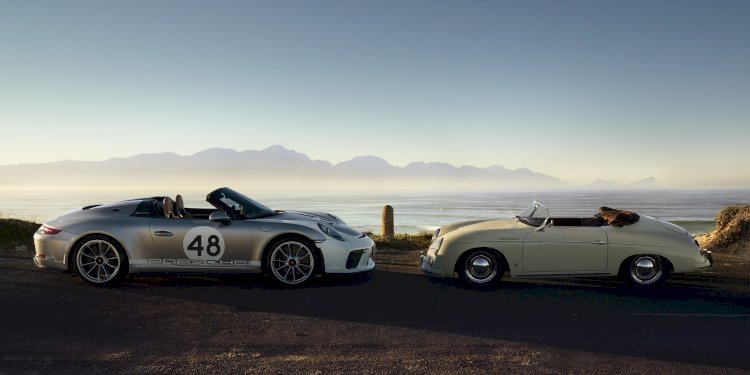Porsche 911 Speedster
The Porsche 911 Speedster already caused a sensation when it was presented as a concept vehicle. Now Porsche is putting the open-top two-seater into production.
 Photo by Porsche AG
Photo by Porsche AG
The 911 Speedster combines the aspiration of a puristic, driver-oriented vehicle with motorsports technology suitable for everyday use. The 911 R (2016) and 911 GT3 served as a basis for development. A high-revving 375 kW (510 PS) four-liter naturally-aspirated boxer engine delivers an emotive sound experience in the cockpit. The six-speed GT transmission is shifted manually. Visually, the new Speedster establishes a bridge to its own history - to the forebear of all Porsche sports cars, the 356 "No. 1" Roadster from 1948. The limited edition of the new 911 Speedster is also reminiscent of this vehicle. Exactly 1,948 units will be manufactured from mid-2019 at the Porsche plant in Zuffenhausen, Germany.
As a concept vehicle, the 911 Speedster celebrated its world premiere in 2018 at the ceremony for the "70 Years of Porsche Sports Cars" anniversary in Zuffenhausen. Other public appearances followed at the Goodwood Festival of Speed, the Rennsport Reunion VI in Laguna Seca, California as well as the Paris Motor Show in October. Numerous Speedster elements that characterize the concept vehicle can now be found in the same or similar design on the series production model.
Taking center stage is the aesthetically shaped convertible top compartment lid with its double-bubble streamliners - a quintessential feature of this sports car type ever since the 911 Speedster from 1988. It is the largest and most complex component to date that Porsche has used in a road model made of a single piece of carbon-fiber-reinforced plastic. Two trim elements in the double bubbles make room for the roll-over protection system as need, included in the two-seater as a standard feature just like in the 911 Carrera Cabriolet.
A weight-saving roof structure replaces the basic tonneau cover of the concept vehicle. Despite its puristic design, the fabric convertible top is suitable for everyday use. Together with the shortened window frames with their lowered cowl top panels and the smaller side windows, it gives the 911 Speedster its athletic profile. The excitingly low fly line already characterized historic designs such as the Porsche 356 Speedster from 1954.
The convertible top takes no effort to operate: the central locking hook at the windscreen frame and both the side fins of the fabric roof are released at the push of a button. The large rear lid made from lightweight carbon fiber is electrically unlocked and slides back a short distance, is then positioned by hand, and makes room for the fabric roof, which folds into a Z shape behind the front seats. The cover can then be closed again effortlessly once the roof has folded into position. The roof is closed again in the same way - only the roof fins on the left and right of the streamliners have to be pressed by hand into their holders until they perceptibly engage.
Rear spoiler and rear apron of the 911 GT3 Touring
The lightweight design also dictates other body components of the Speedster. The carbon-fiber composite bonnet - which weighs in two kilograms lighter than on the 911 GT3 - and the carbon-fiber composite wings originate from the 911 R. The front apron was borrowed from the GT3, but the front spoiler lip is a completely new development. Instead of the Talbot mirrors used on the concept vehicle, the production version of the new Speedster features electrically adjustable and heated Sport Design exterior mirrors. The extending, aerodynamically tuned rear spoiler and rear apron have been adopted from the 911 GT3 Touring for the Speedster.
The interior is characterized by black leather elements for the side bolsters and head restraints of the carbon-fiber composite full-bucket seats, the armrests in the door trims, and the shortened gear lever. The center panels of the seats are upholstered in perforated leather, while the lightweight door panels with a black door pull and stowage nets reduce the overall weight.
"Speedster" logos adorn the head restraints and the visible carbon door sills as well as the central rev counter. Like the other instruments, it has black dials with white needles as well as green digits and scales - features reminiscent of its famous forebear, the Porsche 356 Speedster. A limited-edition badge on the cross structure behind the front seats shows the serial number of the 911 Speedster, which is limited to just 1,948 units.
Porsche also optionally offers the new 911 Speedster with a Heritage Design package. Price in Germany: 21,634.20 Euro incl. VAT. In Germany, prices for the 911 Speedster start at 269.274 euros including VAT and country-specific equipment. It can be ordered immediately.
Find more Cars
The Bentley Flying Spur S
Bentley is completing its new driver-focused S range with the launch of the...
An Open Show of Carbon and Emotion: Gemballa GT Ca...
The Porsche 991 Carrera S Convertible combines speed and style with an enth...
Zenvo ST1
S stands for Supercharger, T for Turbo, and 1 for model number one. This is...
Ferrari F12tdf
Ferrari reveals the F12tdf which pays homage to the Tour de France, the leg...
The new Lamborghini Urus S
The new Lamborghini Urus S delivers power increased to 666 CV, matching the...
Bentley Brings More Power to the Ice in 2014
Bentley returns to the snow-covered wilds of the far north of Finland this ...




















